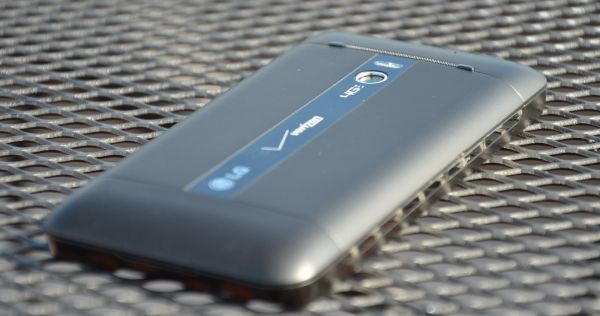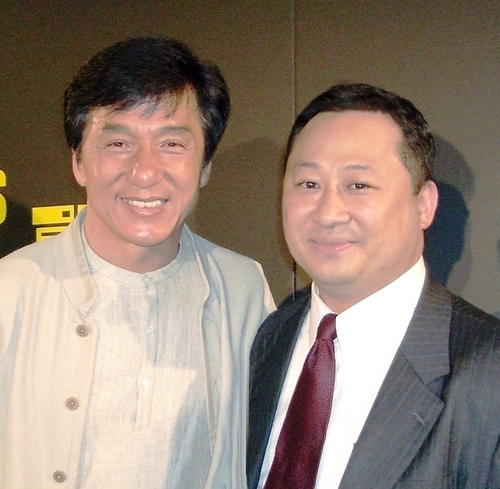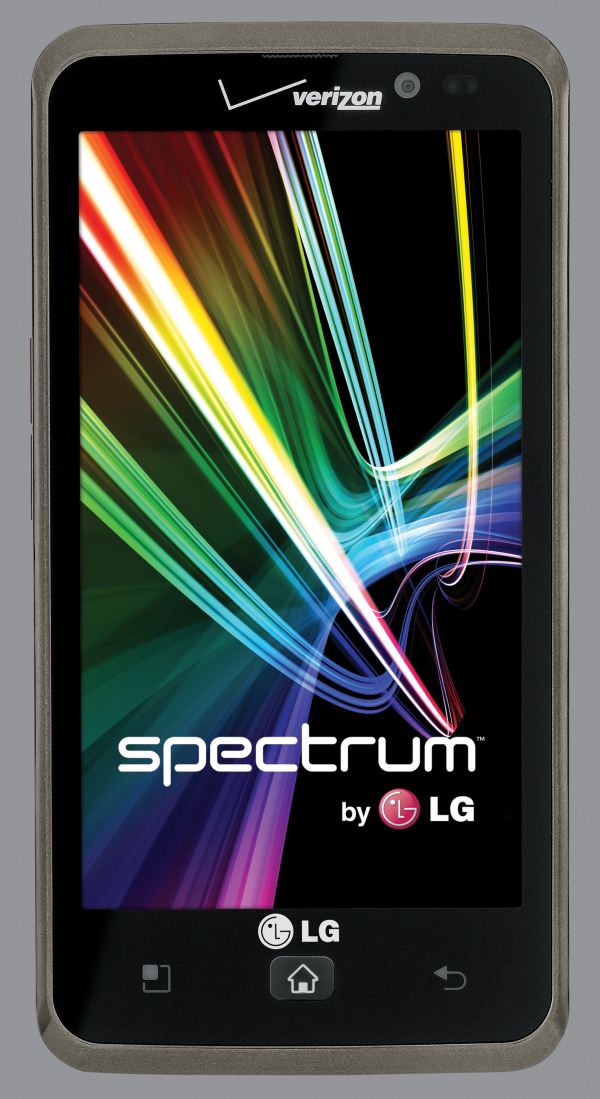LG's G6 Series: A New Kind of Google TV Partnership
by Jason Inofuentes on February 6, 2012 10:43 PM ESTA common feature in some of the world's most succesful companies is an evangelist. Sometimes that person will be a founder or CEO, other times it will be a salesman or marketing and public relations person. Whatever their role, the evangelist will be passionate about the company, their goals and their products, and if you encounter them, they won't rest until you are as passionate. For LG Electronics, the chief evangelist is a man by the name of Ken Hong.
Ken Hong (Right), with Jackie Chan (Left)
Like many of the Korean technology companies, LG Electronics sits beneath a parent company whose holdings include component makers for their various end consumer products. The synergy opportunities and cost savings of producing your own displays, ICs, software and other components can’t be undersold. And R&D wins translate not just into component sales, but end unit sales. So as a display division develops an innovative screen technology, that success goes into the next handset or television console.
Component R&D requires extensive resources (pronounced money), untold numbers of man hours and a certain amount of time. Generally, throw more money or man hours at something and you’ll need less time to reach a solution. That R&D is just part of the solution. And watching Ken Hong at work, you realize the R&D guys have it easy.
When I met with Ken, officially LG's Global Communications Director, for a tour of the LG Electronics booth at CES, I expected him to be courteous and show me some of the highlights. I expected him to offer talking points and to stray not far off the script. I expected answers to some questions, and a polite “No comment,” to other questions. What I got was an hour long, frank and in depth discussion about LG Electronic’s road map for 2012 and beyond, and a close look at a truly surprising collaboration.
The Year That Was
In 2011, LG had three marquee phones come to market in the US, the LG G2X, LG Thrill 4G and LG Revolution. Each phone was a first for LG: the G2X was the first dual-core phone, the Revolution was their first LTE phone and the Thrill 4G was the first 3D phone with both a 3D display and camera. Developing, announcing, producing and shipping three halo phones in one year is a massive undertaking. And it may have been too much.

Despite surviving the massive undertaking and having three impressive devices to show for it, neither of those phones is on the tips of everyones tongues. Indeed, when you look back on the year only a few phones stand out in what was a terribly crowded release schedule. And none of those phones is an LG.
Yet despite not having the mindshare penetration they might have hoped for, LG has kept hard at work, improving their released products through software updates, and preparing new devices for release. Late last year they released the LG Optimus LTE, featuring an HD IPS display and an iPhone baiting pixel density. It was rebranded the Nitro HD for AT&T and released as one of their first LTE phones; and was announced on Verizon ahead of CES as the LG Spectrum.
So, maybe not the mindshare they hoped for, maybe not the marketshare they hoped for, but that’s hardly slowed them down.
The Elephant
Whenever we engage a representative of a company, there’s a tendency to avoid mentioning their direct competitors by name. Most often, it’s out of courtesy; they know who their competition is, they don't need us to phrase every question as “Company X did it this way, what will you do?” LG’s competition is local. Samsung is one of the most vertical companies in the world, and they leverage that into marketing across the entire spectrum of consumer electronics. LG’s coverage of that same spectrum is nearly as exhaustive, but they’re not quite as vertical as their competition, and not nearly so large.
With Samsung’s size, they can throw more resources at their projects, which means lower time to market. LG’s R&D goals, then, must focus on creating better solutions and targeting markets that Samsung isn’t. And, where necessary, expand their business to include areas in which Samsung already has a lead.












5 Comments
View All Comments
aryonoco - Tuesday, February 7, 2012 - link
"Going forward from Android 4.0, device manufacturer’s would be required to build their skins within the Theme framework Google provides, and that at all times, access to the default Holo theme would be retained. While this would still allow for OEM and carrier defined widgets and software preloads, the user would have access to the default core UI."No no no, this is wrong. This is not what's happening.
The Holo theme has to be present on the device, umodified, so that applications that want to use it can leverage it. The user has absolutely no say in what theme the app will use. OEMs can define their own theme, and Holo has to be present as well. Then, an app developer can either target the device native theme (i.e., the carrier theme) or the Holo theme, or define their own theme if they wish. There is nothing that says that a user has control over this.
"And all this is muddled when you see that some devices that blatantly break with the speculative standards Google sets for products are granted access to the Market."
Can you name one of these products which allegedly break the CTS and legally carry Market and other proprietary Google Apps? Cause I don't know of any, as as far as the ODMs that I've talked to are concerned, there is nothing "speculative" about the CTS. It's out there in the open for anyone to read:
http://source.android.com/compatibility/cts-intro....
Anandtech has for the past two years or so, had the best coverage of the mobile industry and Android in particular, bar none. I would hate for misinformation to be spread around via this credible source, without any credible evidence.
JasonInofuentes - Tuesday, February 7, 2012 - link
I appreciate the clarifications. After looking into it and talking to Brian, you're right, I got the Holo theme details wrong, and will update as suited. As far as the Market access rules though, this is a situation that has improved significantly of late, but is not so cut and dry as you think.The CTS ensures that a device meets a certain technical compatibility with Android and with Android apps, however it is not the only hurdle that must be met to obtain Market access. From the CTS FAQ:
"If my device is compatible, does it automatically have access to Android Market and branding?
Android Market is a service operated by Google. Achieving compatibility is a prerequisite for obtaining access to the Android Market software and branding. Device manufacturers should contact Google to obtain access to Android Market."
The Android Market is the value add by which Google leverages power over device manufacturers. When a company approaches Google with a CTS compliant device and seeks access to the Android Market, they negotiate an agreement and based on their compliance with the agreement they do or do not receive access. These agreements are private and covered by NDAs and rarely see the light of day. The last time one did was during the proceedings of a lawsuit brought by Skyhook, against Google.
The Verge (nee This Is My Next) covered this matter when it broke. (http://www.theverge.com/2011/05/12/google-android-... In that instance the devices in question had Market access revoked late in the product development cycle because of a dispute over which location service would be used. Ultimately, Samsung complied with Google's requests, and it seems likely that as a result of this exposure the CTS and ACD were made public (note that the CDD, previously the ACD, is on just its second revision as of last month). Making these things public removes the threat implicit of having to comply by a hidden document (and the license agreements exposed in the lawsuit make it clear that previously the CTS and ACD could be changed up until the moment of product release). But just because the CTS and ACD are public doesn't mean that Google must grant access to all products that meet CTS and ACD.
As far as examples of device that seemed to breach the assumed contents of the previously unpublished ACD? The OG Galaxy Tab is a good example. Prior to Samsung's Tab, several smaller manufacturer's (Viewsonic and Craig come to mind) had produced Android based tablets. None of them was granted Market access and the operating theory was that a cellular data modem and some form of telephony were a requirement for access; this was a safe assumption since Android was designed for phones, and up until the iPad, tablets seemed a niche market. But when the Galaxy Tab was announced it was noted as featuring the Android Market.
Even turning to Lenovo's announcement can show the lack of clarity. Lenovo's K91 one-ups Google itself by bringing ICS to TVs well ahead of Google's expectations, and is touted as having Market access. It's also acknowledged to be a Chinese market-only device. One problem: The Android Market isn't yet available in China, and possibly never will be. Ignoring the question of whether Market will ever reach China, does this mean that if Samsung chose to produce an ICS-based Smart TV that they would be granted Market access? It would be against Google's best interests to empower a manufacturer to fork Android-based TV's into Google TV's and Other.
Again, with a published CTS and the ACD/CDD this process is much clearer, but it's still ultimately a business negotiation the details of which are not known to the public, and this can lead to confusion.
aryonoco - Wednesday, February 8, 2012 - link
Thank you for your reply and clarification.You bring up good points about the CTS and Market certification. The original Galxy Tab was indeed an anomaly, and the recent Lenovo Android TV announcements had me puzzled as well.
I do however think that for the most part, this ambiguity is a reflection of fine balance that the CTS has to struck, in order to preserve compatibility and avoid fragmentation, while at the same time allowing Android to innovate and continue exploring new territories (like tablets, and now TVs). In order to perform such a function, the CTS has to be updatable by its nature to reflect the current versatility and maturity of the platform.
I think many of these ambiguities in Market certification and Google' reluctance to see Android deployed in areas it had not been designed to are a result of Android's earlier lack of suitability to scale in these areas. With ICS, a single platform can indeed scale from a 3" smartphone to a 70" TV and everything in between, while preserving app compatibility and layout. The newfound openness in the CTS probably also reflects that Google feels confident in the maturity of the platform, and that it can withstand challenges of being deployed in widely different environments.
Having said that, I wholeheartedly agree with you that the situation is less than completely transparent and less than ideal. It would be to everyone's advantages if the rules were out in the open, and merely complying with the CTS would guarantee Market certification. Unlike you, I don't think Google would actually lose anything if a manufacturer ran a fully-compliant ICS in their TV with access to Market, as opposed to the official Google TV. They both equally serve Google's intended purposes well.
8steve8 - Tuesday, February 7, 2012 - link
companies are so silly, trying to differentiate for the sake of differentiation...use google's 'skin', and the industry will have a familiar, clean, reliable, fast interface...
all these efforts at differentiation in android is only hurting the entire android movement.. LG/samsung etc suck at ui design... even if they were good, its an unnecessary tangent.
They all think consumers care/value their additions/customizations, which is blatantly false and maybe egotistical.
KalleSverige - Thursday, May 3, 2012 - link
Man, you are so wrong. Companies and Android phones need differentiation - even much more than today! Otherwise we'll have a boring ecosystem of similar look&feel Android devices. No matter what proprietary UI skins they have you can still clearly say what OS platform is giving those devices their kicks.If you are happy with "clean" and "reliable" user interface of Android, I strongly recommend that you stick with Google Nexus year 2009 model and enjoy your 4 colors on it.